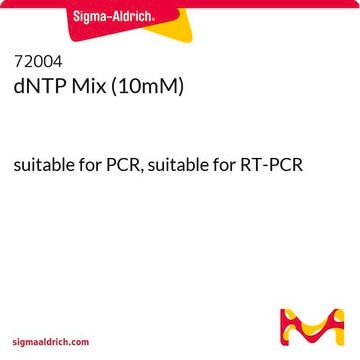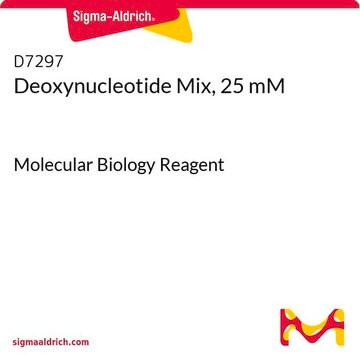DNTPCA1
CleanAmp™ dNTP
Hot-start dNTP mix for improved PCR
Synonym(e):
Deoxynucleotides, dNTP, dNTP Mix
About This Item
Empfohlene Produkte
Form
liquid
Leistungsmerkmale
hotstart
Konzentration
10 mM (each dNTP)
Farbe
colorless
Versandbedingung
dry ice
Lagertemp.
−20°C
Suchen Sie nach ähnlichen Produkten? Aufrufen Leitfaden zum Produktvergleich
Allgemeine Beschreibung
Anwendung
- For PCR amplifications that require reduced non-specific amplification
- For multiplex PCR
- For reduction of primer dimers
- Substitute for dNTPs in any PCR reaction
Verpackung
10 μmoles: 1 vial, 1000 μL, each dNTP at 10 mM in 50 mM Glycine
Rechtliche Hinweise
Lagerklassenschlüssel
12 - Non Combustible Liquids
WGK
WGK 2
Flammpunkt (°F)
Not applicable
Flammpunkt (°C)
Not applicable
Analysenzertifikate (COA)
Suchen Sie nach Analysenzertifikate (COA), indem Sie die Lot-/Chargennummer des Produkts eingeben. Lot- und Chargennummern sind auf dem Produktetikett hinter den Wörtern ‘Lot’ oder ‘Batch’ (Lot oder Charge) zu finden.
Besitzen Sie dieses Produkt bereits?
In der Dokumentenbibliothek finden Sie die Dokumentation zu den Produkten, die Sie kürzlich erworben haben.
Kunden haben sich ebenfalls angesehen
Artikel
Mögliche Ursachen und Abhilfemaßnahmen für Probleme, die bei der Vorbereitung von Proben für SDS-PAGE (Natriumdodecylsulfat-Polyacrylamid-Gelelektrophorese) auftreten, und Optimierung der Elektrophoresebedingungen.
Identify causes and remedies for SDS-PAGE sample preparation challenges and optimize electrophoresis conditions.
Unser Team von Wissenschaftlern verfügt über Erfahrung in allen Forschungsbereichen einschließlich Life Science, Materialwissenschaften, chemischer Synthese, Chromatographie, Analytik und vielen mehr..
Setzen Sie sich mit dem technischen Dienst in Verbindung.











